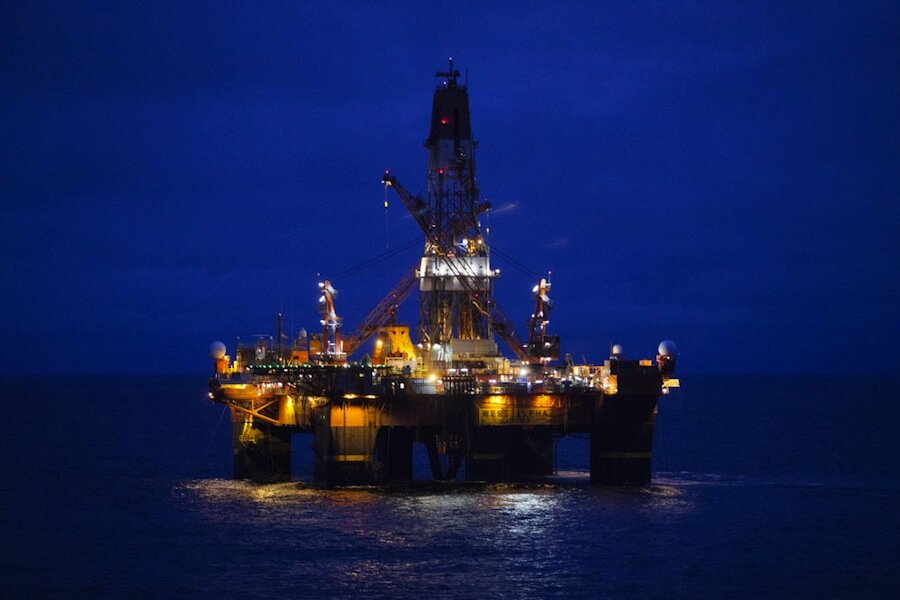Russia to power Arctic drilling with floating nuclear reactors
Loading...
It would sit in the icy waters of the Arctic, and provide a constant supply of electricity to a massive rig drilling for oil. They could be mass produced, potentially cutting the cost of drilling projects. The twist? The electricity on these floating power plants would come from a nuclear reactor.
Russia is looking to deploy a floating nuclear reactor that could help power ports, industries, and also offshore oil and gas drilling in the Arctic. In what sounds like a horrible nightmare for environmentalists, floating nuclear reactors could help produce more oil in the Arctic.
Russia’s reactor, called the Akademik Lomonosov, will be about the length of one and a half football fields, and will have the capacity to produce 70 megawatts of electricity. It is not self-propelled, but future mobile reactors will be. Russia plans on mass producing them once the Akademik Lomonosov proves itself. The small floating reactors will be on icebreakers, so they will be able to navigate icy Arctic waters. (Related: How To Spot An Undervalued Oil Company)
Construction began on the Akademik Lomonosov in 2007, but has suffered delays. But Russia’s Deputy Prime Minister Dmitry Rogozin said during a recent trip to the Arctic that Russia hopes to have a floating nuclear reactor running by October 2016. It will provide power to the Arctic town of Pevek in the East Siberian Sea. “It is basically an atomic reactor that can be docked to coastal infrastructure, and it will provide energy through a cable to any Arctic city,” Rogozin said.
According to Russia’s state-owned nuclear firm Rosatom, at least 15 countries, including China, Algeria, Indonesia, Malaysia and Argentina, are interested in deploying floating nuclear reactors as well. In fact, last year, during Russian President Vladimir Putin’s visit to Shanghai, Russia and China signed an agreement to cooperate on building a floating nuclear power plant. (Related: Putin Betting On An Argentinian Shale Boom)
A Canadian company Dunedin Energy Systems is proposing something similar. The Ontario-based company wants to sell small floating nuclear reactors in Canada’s far north that would provide a power source for remote mining projects. Dunedin’s President points out that floating nuclear reactors are safe and have been around since the 1950’s when the USS Nautilus, a nuclear-powered submarine, hit the high seas.
Floating nuclear power plants would provide companies drilling for oil and gas or extracting minerals an energy source in faraway places. They would not need to be refueled for an extended period of time and the power supply would be constant. The floating reactors would be towed – or would self-propel – into place and then be easily removed when a drilling project is finished. Dunedin argues the cost would be much lower than diesel-powered generators. Until one is actually up and running, however, the economics are far from proven.
Drilling for oil and gas in the Arctic is tremendously expensive and difficult. Floating reactors could theoretically make it easier. If Russia’s Akademik Lomonosov demonstrates its usefulness, that could accelerate the pace of drilling. (Related: Former BP Chief Sees Oil Price Rebound Soon)
In American waters, however, it is hard to see how anything would change for the foreseeable future. Royal Dutch Shell is the only company with any realistic plans to drill in the near term. In large part due to its own mistakes, Shell has already been delayed by regulatory hurdles. But if it, or any other company, were to consider using floating nuclear power plants off the coast of Alaska, it would face a whole new set of regulatory challenges. That probably means floating nuclear power plants are not coming to the U.S. Arctic anytime soon, even if Russia starts ramping up production of them.
On the other hand, if Russia starts drilling at a quicker pace in the Arctic due to these floating reactors, that would in turn put pressure on American lawmakers to make it more attractive for oil companies to drill in the Chukchi and Beaufort Seas, out of a fear of falling behind. That could lead to Congress or the administration slashing regulations and/or selling off more offshore Arctic acreage.
Much remains to be seen. Russia’s floating nuclear power plant has been a struggle to complete, and it may not live up to the hype. But if it delivers, it could alter the course of Arctic drilling.
By Nick Cunningham of Oilprice.com
More Top Reads From Oilprice.com:
- Big Hit For U.S. Oil Production In January
- A Plot To Hold Down Oil Prices Or Just A Happy Coincidence?
- An Unlikely Winner Of The Ukraine-Gazprom Row
Original article: http://oilprice.com/Alternative-Energy/Nuclear-Power/Russia-To-Power-Arctic-Drilling-With-Floating-Nuclear-Reactors.html
Source: http://oilprice.com/





